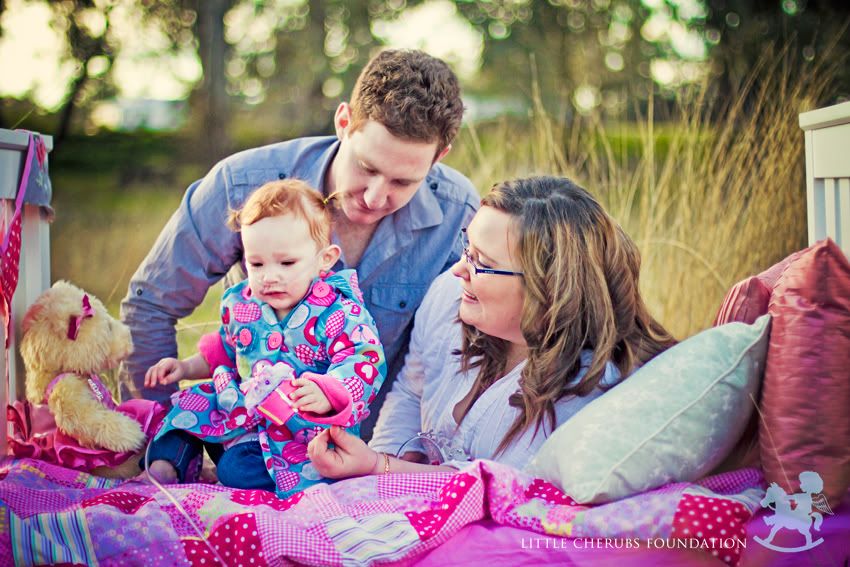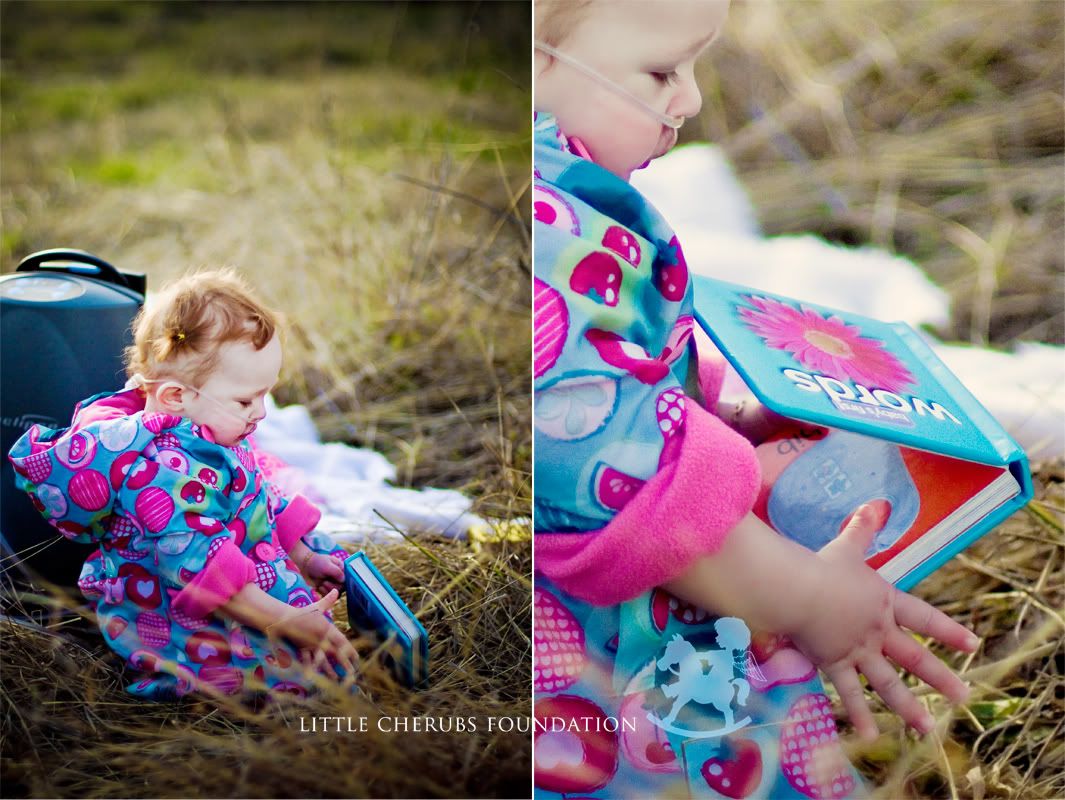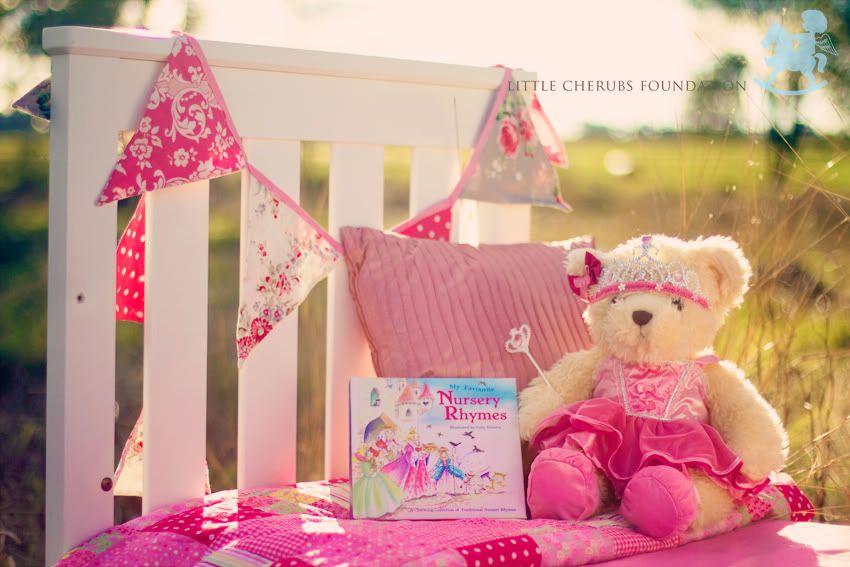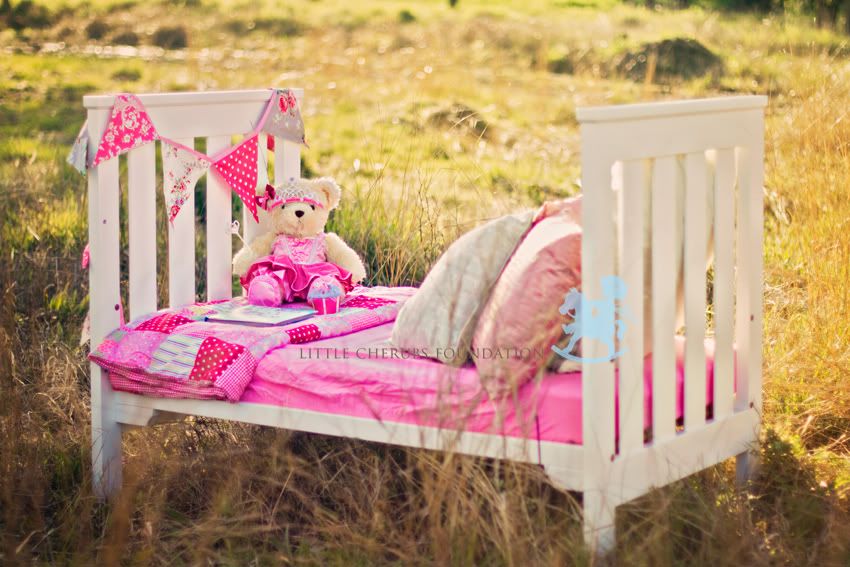Here is little Eloise's story... as told by her Mummy...
"Eloise Rose Taylor was born on February 12th, 09. 8 Pounds one ounce, 53.5cm long. Our beautiful girl was born healthy, until she was a few days old when she developed a haemangioma on her lip and mouth. It quickly grew so swollen that she had trouble drinking, so she started on steroids to reduce its size. By the time she was about 5 months of age, her haemangioma was slowly becoming worse, and there were so many side effects to the drug, that her case was moved over from Randwick children’s to westmead children’s and her medication was swapped to beta blockers instead, which Is a drug conventionally used for high blood pressure, but is surprisingly safe compared to the steroids. In a month her haemangioma was merely a “birth mark”, and it continues to dissapear.
In august 09 we were caught off guard as we went out for the first time to celebrate Michaels birthday, and she had her first epileptic seizure. It was hard to believe until in the emergency triage room she had her second one, in my arms. Then she had another one a few hours later and she was immediately put on an epilepsy drug. We spent the week after that in hospital with her, and an E.E.G and a couple of tests later, they really weren’t sure what was going on. So they sent us home with a weaning schedule for the medication. On the last day of the schedule, she had another seizure. This time it was 5 times as long. After another inconclusive E.E.G we were sent to westmead for a M.R.I scan.
But we discovered a lot more than we had hoped. While performing the MRI scan, they discovered she was in respiratory distress and hypoxemic, which means her blood oxygen was at dangerous levels. After the MRI she was diagnosed with epilepsy. But her lung condition was harder to diagnose. After a long stay of months, and many tests, including a CT scan, many chest x-rays, an ECG, an ultrasound on her heart, a barium swallow, a endoscopy, bronchoscopy, blood tests, overnight sleep study, and many more, they decided that a lung biopsy was the only hope left. After the lung biopsy Eloise caught a common virus, and she became even sicker, and her supplemental oxygen requirement increased significantly. After many weeks, she finally improved but her oxygen requirements have never fully recovered to before she caught that virus. We were eventually sent home via air ambulance to our local hospital with no diagnosis, the possibility of interstitial lung disease (which has many heartbreaking outcomes) and left wondering if our little girl was going to grow up.
In January we went back to Westmead to do a sleep study, to determine the exact amount of medical oxygen she requires while asleep and to see if her condition had improved. The biopsy results had been sent to Dr. Young at Texas, United States. She is one of the world’s leading doctors in children’s interstitial lung disease. She discovered that Eloise has NEHI, Neuroendocrine Cell Hyperplasia of infancy, a type of interstitial lung disease. It's very rare, children’s interstitial lung disease itself effects 3.4 people per million and NEHI, the type Eloise has has only effects around 150 people in the world.
In august 09 we were caught off guard as we went out for the first time to celebrate Michaels birthday, and she had her first epileptic seizure. It was hard to believe until in the emergency triage room she had her second one, in my arms. Then she had another one a few hours later and she was immediately put on an epilepsy drug. We spent the week after that in hospital with her, and an E.E.G and a couple of tests later, they really weren’t sure what was going on. So they sent us home with a weaning schedule for the medication. On the last day of the schedule, she had another seizure. This time it was 5 times as long. After another inconclusive E.E.G we were sent to westmead for a M.R.I scan.
But we discovered a lot more than we had hoped. While performing the MRI scan, they discovered she was in respiratory distress and hypoxemic, which means her blood oxygen was at dangerous levels. After the MRI she was diagnosed with epilepsy. But her lung condition was harder to diagnose. After a long stay of months, and many tests, including a CT scan, many chest x-rays, an ECG, an ultrasound on her heart, a barium swallow, a endoscopy, bronchoscopy, blood tests, overnight sleep study, and many more, they decided that a lung biopsy was the only hope left. After the lung biopsy Eloise caught a common virus, and she became even sicker, and her supplemental oxygen requirement increased significantly. After many weeks, she finally improved but her oxygen requirements have never fully recovered to before she caught that virus. We were eventually sent home via air ambulance to our local hospital with no diagnosis, the possibility of interstitial lung disease (which has many heartbreaking outcomes) and left wondering if our little girl was going to grow up.
In January we went back to Westmead to do a sleep study, to determine the exact amount of medical oxygen she requires while asleep and to see if her condition had improved. The biopsy results had been sent to Dr. Young at Texas, United States. She is one of the world’s leading doctors in children’s interstitial lung disease. She discovered that Eloise has NEHI, Neuroendocrine Cell Hyperplasia of infancy, a type of interstitial lung disease. It's very rare, children’s interstitial lung disease itself effects 3.4 people per million and NEHI, the type Eloise has has only effects around 150 people in the world.
Neuroendocrine Cell Hyperplasia is much of a mystery in the medical world, all is known is this.
All babies are born with Neuroendocrine Cells, to help with lung development. but within the first 12 months, these cells normally dissapear because they are no longer needed. Eloise, and other kids with NEHI are either born with too many cells, or the cells multiply instead of dissapearing. It is not known why this happens, or how it reduces the ability of the lungs to supply oxygen to the body. Because NEHI is an ultra-rare disease, there is little funding available for research.
Not much is known about the long term impact this disease has on children with NEHI. It appears that some children will slowly grow out of their symptoms, over many many years, or remain stable for a long time. But there is no concrete outcome for this disease, as so little is known. What is known is that children with NEHI require oxygen support for many years, and a high percentage develop problems gastro intestinally, in the form of GERD, a severe form of reflux, failure to thrive and many other problems. Eloise had struggled with severe reflux from an early age, as well as failure to thrive. But since being on 24hr oxygen support, her symptoms have dramatically reduced.
Her respiratory rate is very high, up to 80 breaths per minute, which is more than one every second. Without oxygen, her respiratory rate has been recorded as high as 120 breaths per minute. That’s 2 breaths every second. Try it yourself, try and fit 2 breaths into a second on a clock and see how exhausted you are after a couple of tries!
She gets sick very easily, when she catches a common virus she will usually be admitted to hospital. Because her body is already so overworked, her body just collapses under the pressure of a virus that most of us would shake off easily.
Financially, this disease is crippling. Up until a couple of months ago, we were spending hundreds of dollars per month on oxygen tanks, just so we could take Eloise outside. The government subsidy program for oxygen dependant people supplies us with a stationary concentrator for home use, which meant we were confined to the house. Just to go to the supermarket was a big problem. Waiting in line it would get very stressful, if the line was long there was a fear of running out of oxygen, and the stress of the amount of money it was costing us to stand there in line! The tanks were very heavy and uncomfortable to carry, and many times I would lie on the floor at night because my back was so sore from carrying it around all day. In july we received a portable concentrator from the Regional oxygen bank, a local charity that supports people who are oxygen dependant. This changed our lives significantly. It feels like freedom! The portable concentrator allows us to go out shopping, drive up to westmead hospital for appointments, sit in the emergency room for hours, and even go to the park for a play without the hundreds of dollars a month cost! It is also much safer when travelling, as oxygen tanks explode like a bomb if in a car accident or fire. The best part is, if the battery life on the machine is a little low, we can either hop in the car and plug it in, or plug it into the wall to give it a boost. This has saved us financially, and best of all, gives us the closest thing to freedom possible!"
Our thoughts and prayers are with you all...










1 comment:
What an amazing story of strength and love. Hayley, through your images you have shown us a beauty full girl. Through her story, her parents have shared their hearts.
Thank you and much love to all.
k8 xx
Post a Comment